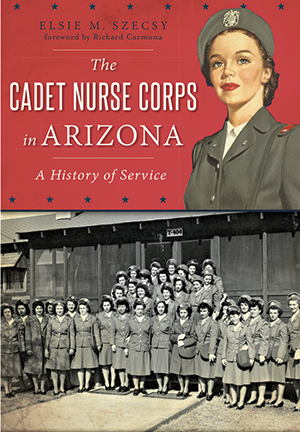
This is Part 5 in our continued series, Healthcare Heroes, where we look back at the profound legacy of American doctors, nurses, and healers.
U.S. Cadet Nurse Corps Legislation and Features

After the United States entered World War II, the need for military nurses quickly emptied hospitals of nurses, thus bringing on a stateside nursing shortage. To address this problem and to avoid a draft for nurses, Congress unanimously approved legislation that resulted in the establishment of the U.S. Cadet Nurse Corps. The U.S. Cadet Nurse Corps started operation on July 1, 1943.
The program was administered by the U.S. Public Health Service, then under the direction of Surgeon General Thomas Parran. Lucile Petry, RN, was the founding director of the Division of Nurse Education, which administered the U.S. Cadet Nurse Corps program. After the war, she became the first chief nurse officer with the rank of assistant surgeon general.
Through the U.S. Cadet Nurse Corps program, the federal government provided qualified schools of nursing funding to cover tuition and fees, stipends and uniforms. Students accepted into the U.S. Cadet Nurse Corps had to be high school graduates between the age of seventeen and thirty- five, be in good health and agree to serve in the nursing profession for the duration of the war to qualify for scholarships, modest stipends and uniforms. Approximately 3,000 African Americans, 350 Japanese and 40 Native Americans became nurses through this program.
Buy the Book: The Cadet Nurse Corps in Arizona by Elsie M. Szecsy
Arizona During World War II

At the beginning of World War II, the United States maintained a neutral posture and did not engage in the war effort. After the bombing of Pearl Harbor, everything changed. During this time the population of California grew 53 percent, Oregon by 40 percent and Washington State by 37 percent. Women became the core of the labor force.
Across the country, around nineteen million women worked in war factories, the transportation industry and agriculture. This period was not called a production miracle for no reason. Cadet nurses in Arizona were training at a time when there was a lot of other war work going on around them, and there were many occupational choices for women that had not existed previously.
Read More: The Cadet Nurse Corps in Arizona by Elsie M. Szecsy
The U.S. Cadet Nurse Corps offered young women in Arizona an opportunity to participate patriotically through service in the state’s understaffed hospitals. The program also promised lifelong benefits in this profession with a future.
Hospital Schools of Nursing in Arizona

Arizona’s five participating schools of nursing in the U.S. Cadet Nurse Corps were at Sage Memorial, Saint Mary’s, Santa Monica’s, Saint Joseph’s and Good Samaritan Hospitals. Saint Mary’s in Tucson trained the largest number and Sage Memorial in Ganado on the Navajo Reservation the fewest. Saint Joseph’s Hospital School of Nursing was the oldest in the state, and Santa Monica’s the youngest. Good Samaritan Hospital School of Nursing was originally known as Deaconess Hospital. All five schools had religious roots, and each had a unique mission and history.
The Good Samaritan Hospital School of Nursing opened in 1920. Over the course of its fifty- three-year history, Good Samaritan Hospital School of Nursing prepared 1,400 young women to be nurses, including Janet Lowe, the hospital’s first baby girl born at the hospital, in 1923.
The Saint Joseph’s Hospital Nurse Training School opened in 1910 with a standardized curriculum that predated national standards for nurse education, which would appear four years later. In 1946, there were 119 students. During World War II, nearly 200 student nurses at Saint Joseph’s were cadet nurses.
Santa Monica’s Hospital School of Nursing was the first integrated hospital and interracial school of nursing west of the Mississippi River. Santa Monica’s was known as a haven “for all races” and had evolved into Phoenix Memorial Hospital by 1951. During its twelve years’ existence, Santa Monica’s graduated between 98 and 145 nurses.
Buy the Book: The Cadet Nurse Corps in Arizona by Elsie M. Szecsy
Saint Mary’s Hospital School of Nursing was established in 1914. In June 1943, the U.S. Cadet Nurse Corps was established at Saint Mary’s. During the first six months of the program, Sister Mary Beatrice Johnson, director of the school, enrolled fifty-four students in the corps. Saint Mary’s Hospital School of Nursing closed in 1966, a casualty of financial pressure and the realization that nurse education had changed and the movement from hospital-based training to college education to prepare nurses was complete.
Arizona’s Cadet Nurses

Federal funding made an enormous difference to young women in realizing their educational dreams by making this educational opportunity accessible. They grew up during the Great Depression, and few would have been able to afford the costs of going to nursing school.
However, it was not only financial motivations that prompted these women to become cadet nurses. The program offered young women the opportunity to serve their country. They had the opportunity to become part of a bigger world than the one in which they grew up.


